FRENCH LETTER
Mellow yellow on my plate (confessions of a weed eater)
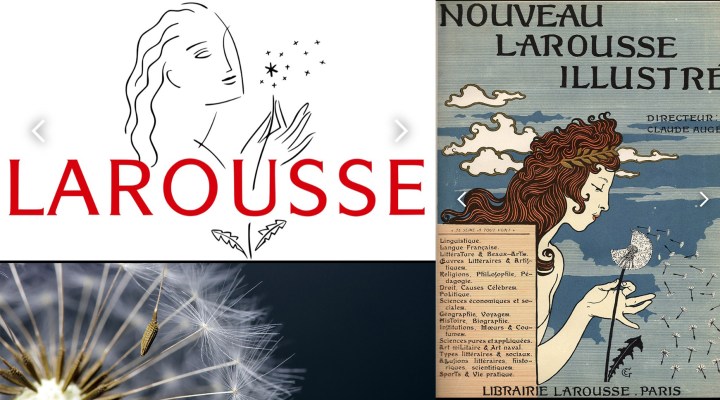
Yellow is the colour that announces spring in France – and dandelion fields turn our thoughts to foraging and playing with flowers in the kitchen.
Yellow is the colour of my true love’s hair… Whenever I’m amazed by anything yellow, I think of Donovan’s song Colours, which I first heard in the ‘70s in Pretoria. A beautiful older boy with a guitar introduced me to the Scottish singer’s greatest hits, including another one about the same colour, Mellow Yellow. I was too young and innocent to catch any reference to vibrators or drugs in this song, but it fixed a musical connection in my mind.
Decades later I wonder if anyone under 40 has even heard of Donovan, but I still remember those lyrics at the end of every long European winter. Suddenly one cold morning the forsythia shrubs are ablaze with bright yellow blooms while the rest of the garden is still brown and bare. Hang in there, the yellow seems to whisper, winter is almost over. A fortnight later the daffodils start showing their droopy yellow heads, and before you know it the fields in the countryside are buttered with dabs of yellow dandelions.
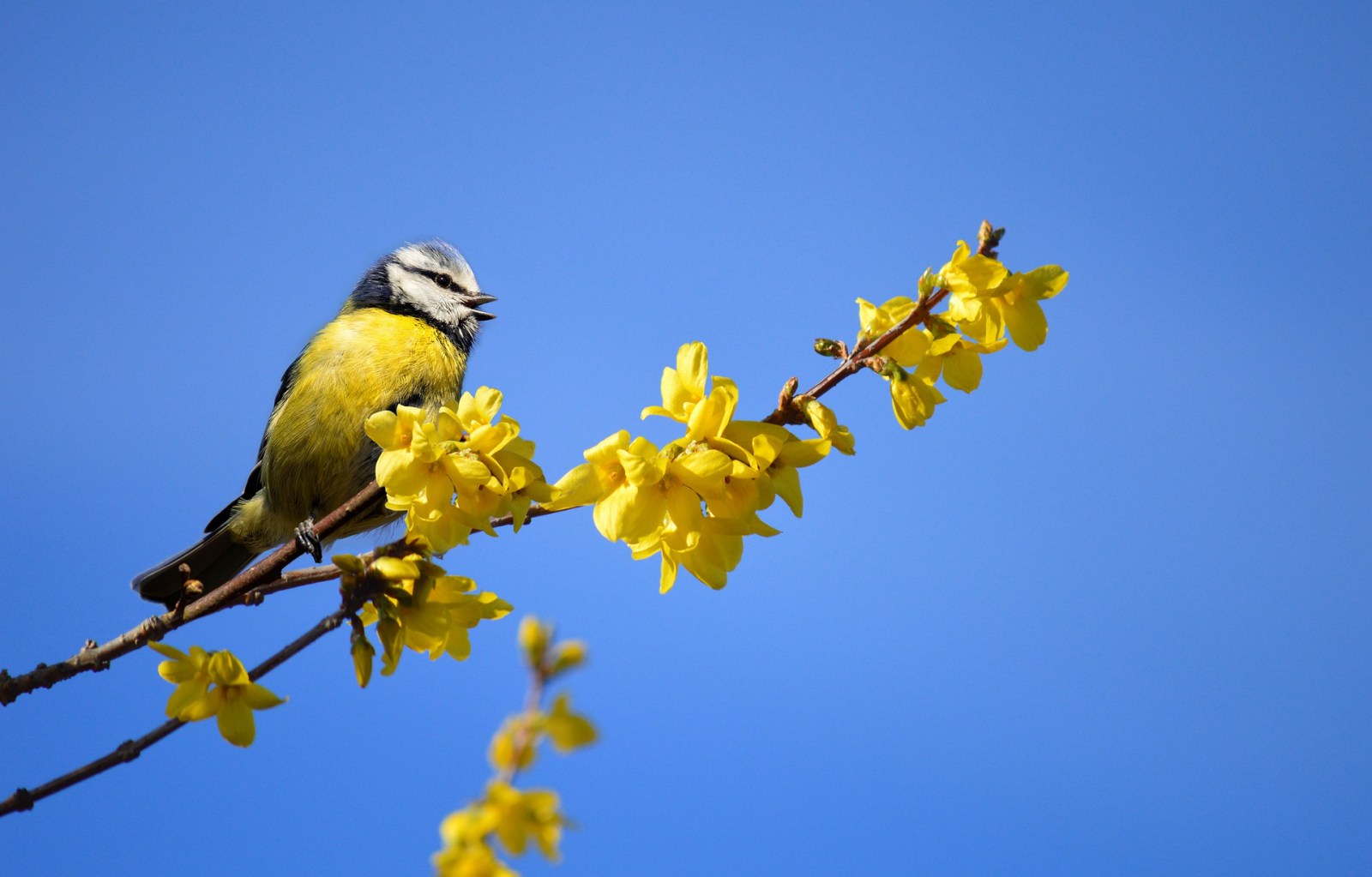
Blue tit and forsythia. (Photo: Frauke Riether on Pixabay)
Then we know that spring is here and we can go foraging again, because every part of this humble weed is edible, from the root and the stem to the leaves and the petals.
As a child I loved blowing on the puff balls that the flowers form once they fade, making a wish while watching the seeds flying like fairies, without realising that dandelions have far more practical uses than my whimsical wishful thinking. I wouldn’t have dreamed that you could eat them. In the suburbs where I grew up, we didn’t eat weeds or flowers. We barely tolerated salad leaves. We much preferred ‘modern’ food from tins and fridges.
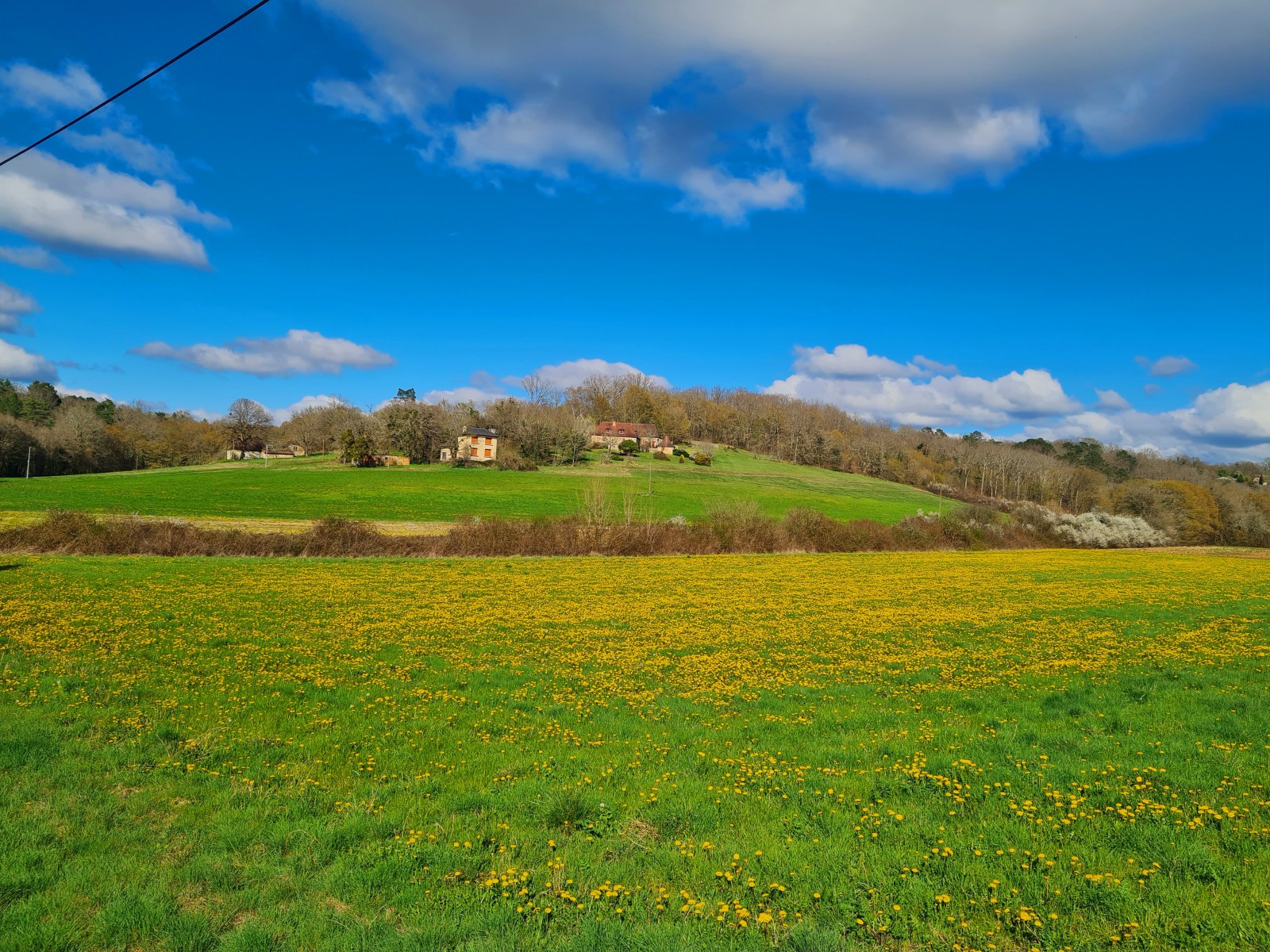
Fields of yellow dandelions announcing spring. (Photo: Marita van der Vyver)
In France, I learnt that you could eat these weeds, raw or cooked, and that they are called pissenlit, which literally means ‘pee in bed’, because of the plant’s highly valued diuretic qualities. I also learnt that the English dandelion is derived from its other French name, dent-de-lion or lion’s tooth, because the jagged edges of the leaves were believed to resemble the teeth of a lion.
Now I know that around 30 species of pee-in-bed, belonging to the Asteraceae family, can be found throughout the world, under various names such as cankerwort, yellow gowan, puffball, or perdeblom (horse flower) in Afrikaans. By the time modern science could inform us that dandelions were rich in Vitamins A, E and C, as well as zinc, iron and calcium, they’d been appreciated as a medicinal herb for centuries and widely used to treat health problems ranging from toothache and arthritis to constipation and skin irritations.
If you add all the practical benefits to the fact that it can be harvested for free all over the world, you might well wonder why dandelions aren’t more commonly used in our kitchens. One reason is probably that the leaves can be quite bitter if you don’t harvest them when they are still small and juicy. The best time to pick the leaves is actually before the flowers appear – which makes it difficult for novices to recognise the plant among all the fresh green growth of early spring.

Playing with flowers in the kitchen. (Photo: Marita van der Vyver)
But if you like the kick of rocket or arugula leaves in a salad, or the lingering aftertaste of endives or Brussel sprouts, or the tang of British marmalade made from Seville oranges – in short, if you believe that bitterness deserves its place on our palate, if not in our attitude to life – then you would probably love the way a handful of dandelion leaves can transform a bland green salad into an intriguing dish. You can throw in croutons or bits of fried bacon for crispiness, or apple slices and almonds with a yoghurt-mayonnaise-honey sauce to take the edge off the bitterness, as we did with our first dandelion salad of the season. And of course, you can scatter the lovely yellow petals over the salad as edible decoration.

Salad of dandelion greens with apple, almonds and yoghurt-mayonnaise-honey sauce. (Photo: Marita van der Vyver)
My favourite party trick with dandelion greens, though, is to treat them almost like spinach, stir-fried with onion and garlic and bacon (or whatever else is available), served with fresh tagliatelle or penne pasta, and generously crowned with grated parmesan. Easy peasy, as the erstwhile Naked Chef used to purr.
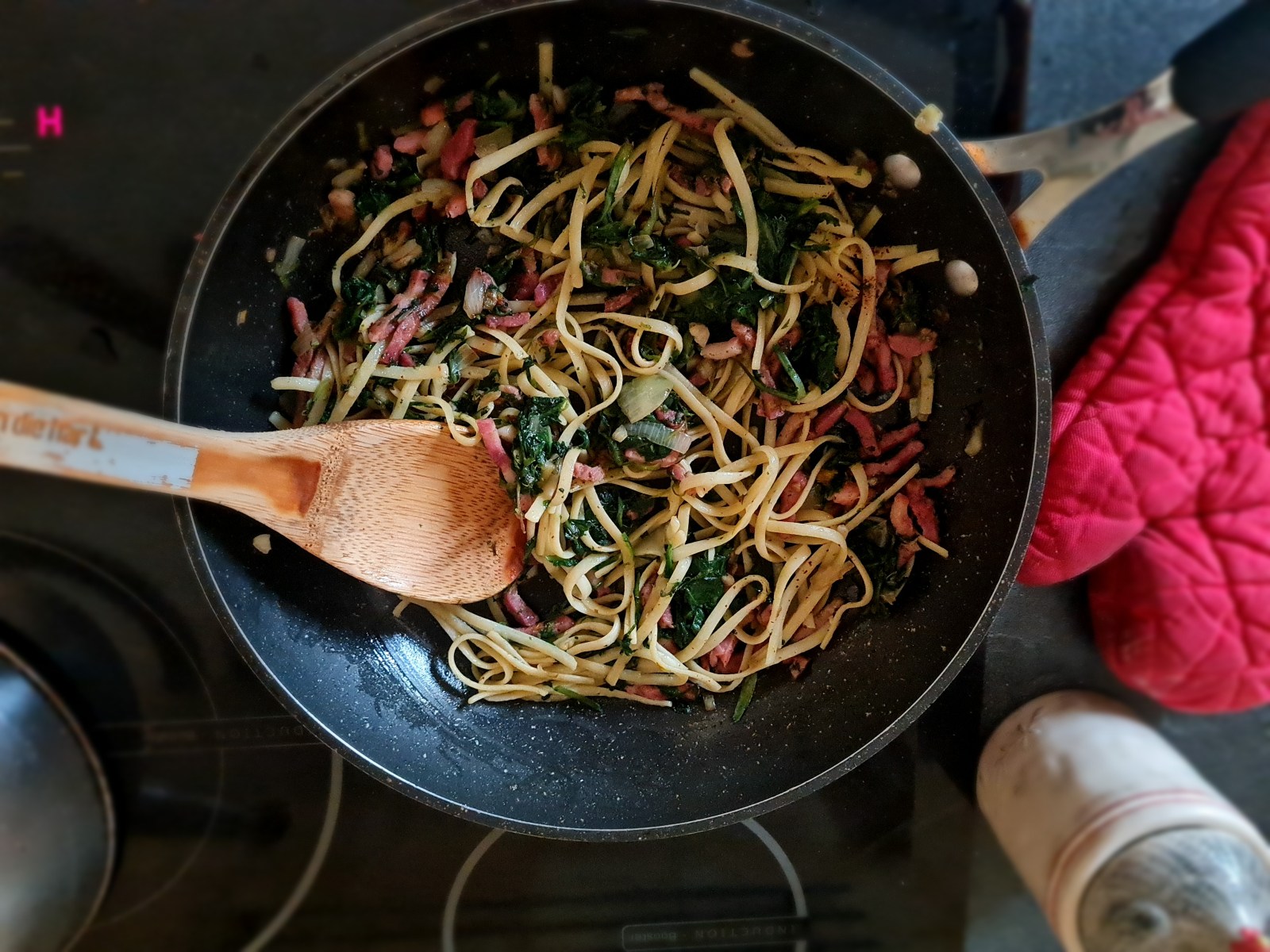
Easy pasta with dandelion greens. (Photo: Marita van der Vyver)
This spring I’m adding another string to my dandelion bow, thanks to a beautiful cookbook, There’s a Vegan on My Verandah, by Louis Jansen van Vuuren and Isabella Niehaus. My partner was asked to translate the book into French, and although we’re not vegan – my Frenchman is a die-hard carnivore – we found quite a few recipes in there to expand our meat-free repertoire.
Among these are no less than three dandelion recipes, one for a pesto made with the greens and two incorporating the yellow petals. Since we love real honey made by real bees we probably won’t attempt the dandelion vegan honey, but we’re looking forward to making dandelion pesto as soon as the spring rains stop and we can venture out again to collect fresh leaves.
We used to regularly make our own pesto – and the Provençal version called pistou – from basil leaves, but as we’re no longer living in a Mediterranean region, and dandelion leaves are much easier to find than basil leaves in the lush green Périgord where we’ve recently settled, we might as well try our hand at dandelion pesto. As the saying goes: “If life offers you lemons…”
At the moment life is offering us dandelions, in profusion, so we’re gratefully making dandelion pesto, dandelion marmalade (from petals cooked with chunks of lemon peel and other fruits) and dandelion honey butter (simply mixing the petals with good butter and real honey, to spread on warm toast, with or without the dandelion marmalade). Who knows, we might even be patient enough to try out the dandelion wine recipe in There’s a Vegan on My Verandah. The wine takes about four weeks to make, and then you have to wait another three months before you drink it, so it’s definitely not a quick fix.
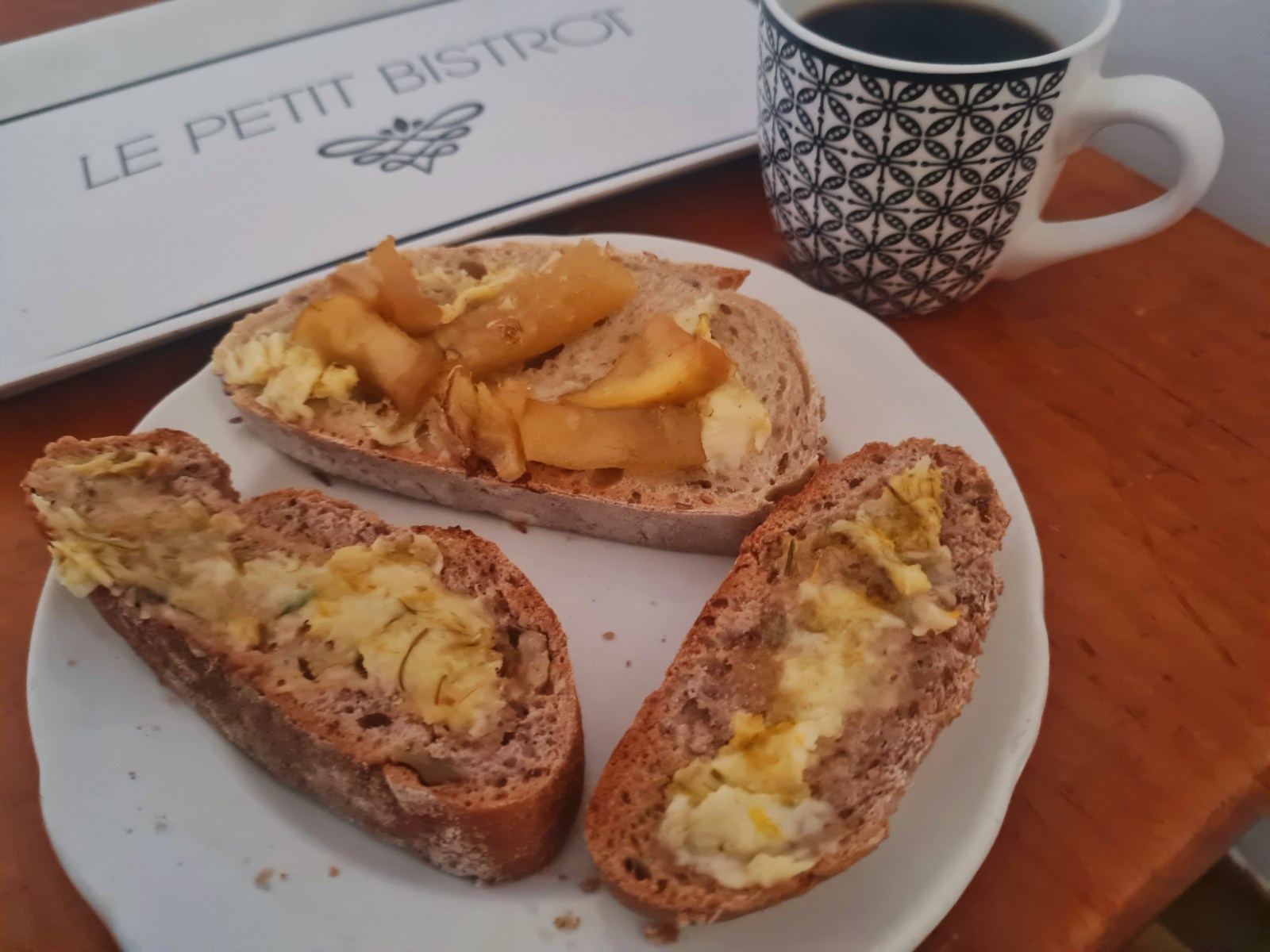
Dandelion-petal butter and dandelion marmalade on warm toast for breakfast. (Photo: Marita van der Vyver)
But while we wait there are many other edible weeds to keep us entertained in the kitchen. Stinging nettles (orties in French) also taste best in spring when they pop up in huge patches along our walking paths, often half-hidden under bramble or blackberry hedges, which makes it quite a challenge to harvest them. You can wear gloves to protect your hands against the famous sting, but then you still have to brave the thorns of the bramble. Then again, perhaps the threat of a little pain makes the end result taste even better, or perhaps I’m just an incurable Calvinist who can’t shake the conviction that I have to suffer for any pleasure. Whatever the reason, the dark green nettle soup we cooked last week was indescribably delicious.
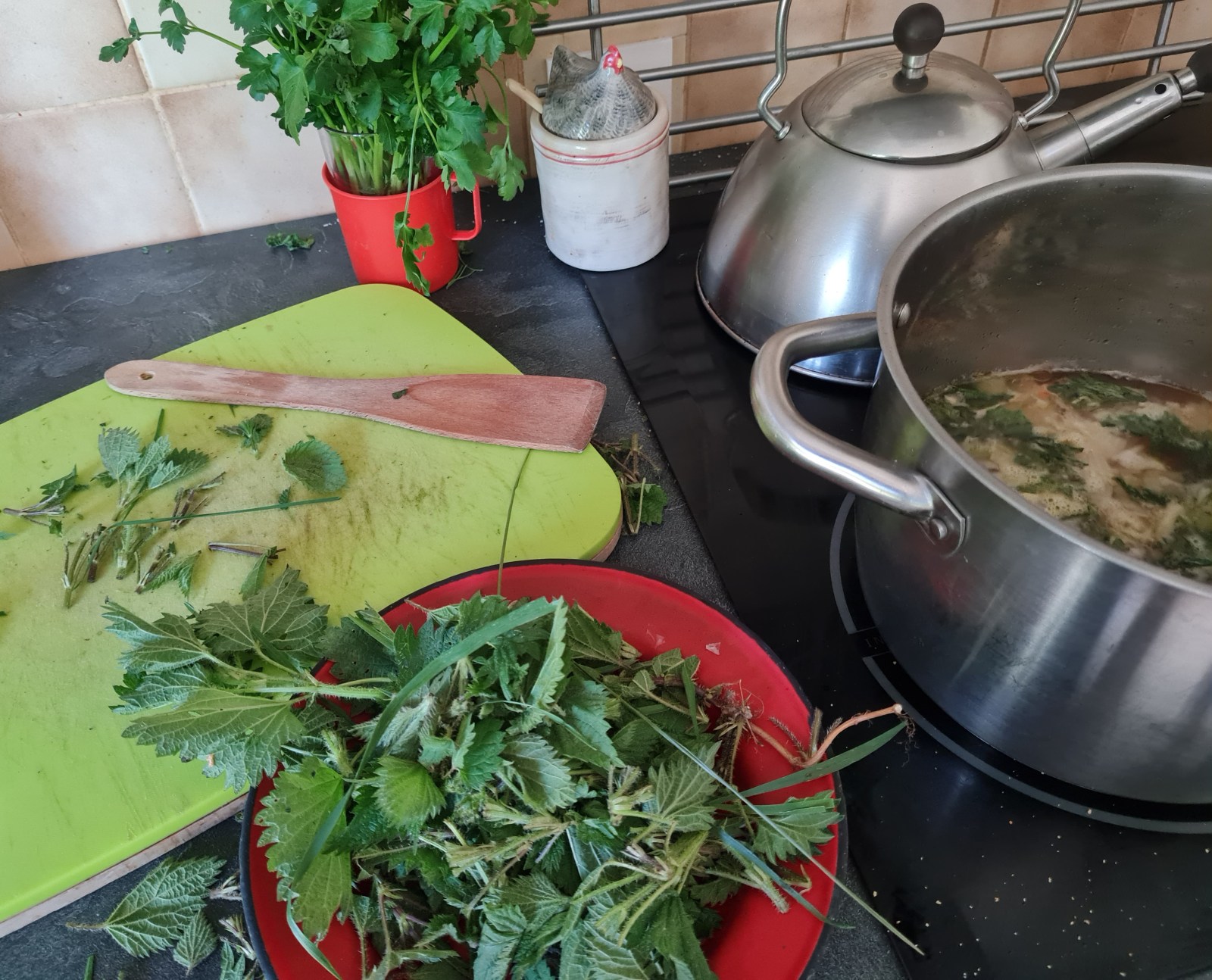
Making nettle soup. (Photo: Marita van der Vyver)
If you’ve never tried nettle soup, that’s another recipe you’ll find in Louis and Isabella’s vegan cookbook. We used a similar recipe, but with chicken bouillon instead of bouillon made from miso paste, and cream from cows rather than from coconuts. We also replaced the leeks with onion and garlic, because the Frenchman believes you can never have enough garlic, and I’ve been living with him long enough to almost agree. And we used only one potato, not six, to ensure the richest emerald green colour possible.
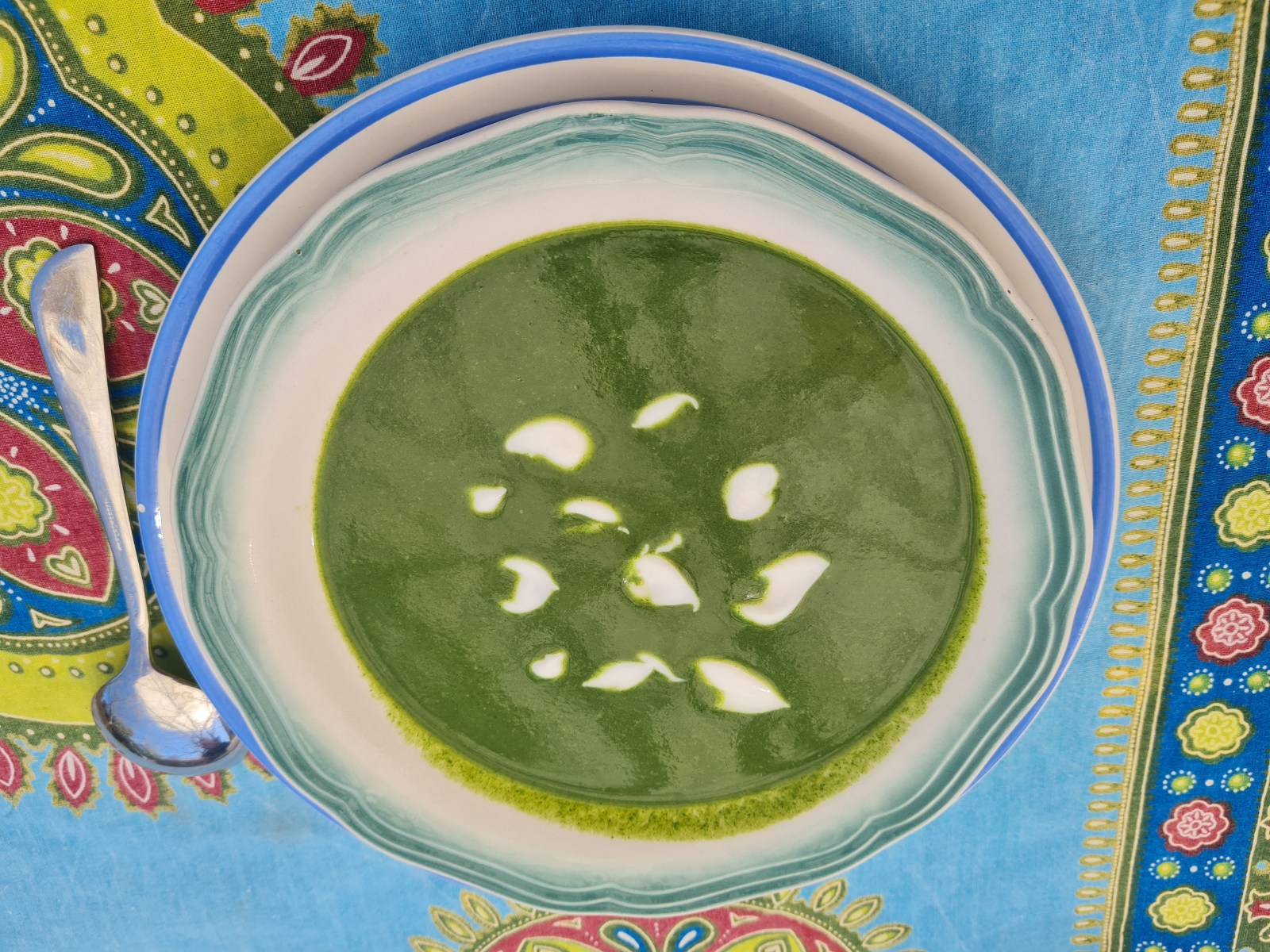
Our deep green nettle soup (with cream from cows). (Photo: Marita van der Vyver)
It was such a treat that we plan to harvest nettles again this weekend – even though our fingers kept tingling for 24 hours after we’d collected our basket of nettles. This time we’ll wear thicker gloves, and we’ll use the stinging leaves for a risotto that I’ve been burning to cook, no pun intended, ever since I tasted a friend’s nettle risotto a couple of years ago.
Most likely we’ll make more nettle soup too, because the very day after we’d slurped down the last of that rich green broth, we discovered borage growing in a hidden corner of our new garden. Just another weed, I would have thought years ago, but now I love the oyster taste of the dainty star-shaped blue flower. And of course they are beautiful enough to decorate any dish, including our next bowls of nettle soup. A few borage blooms scattered on the surface, twinkling like tiny sapphires on dark green velvet, can turn a simple soup into an artwork.
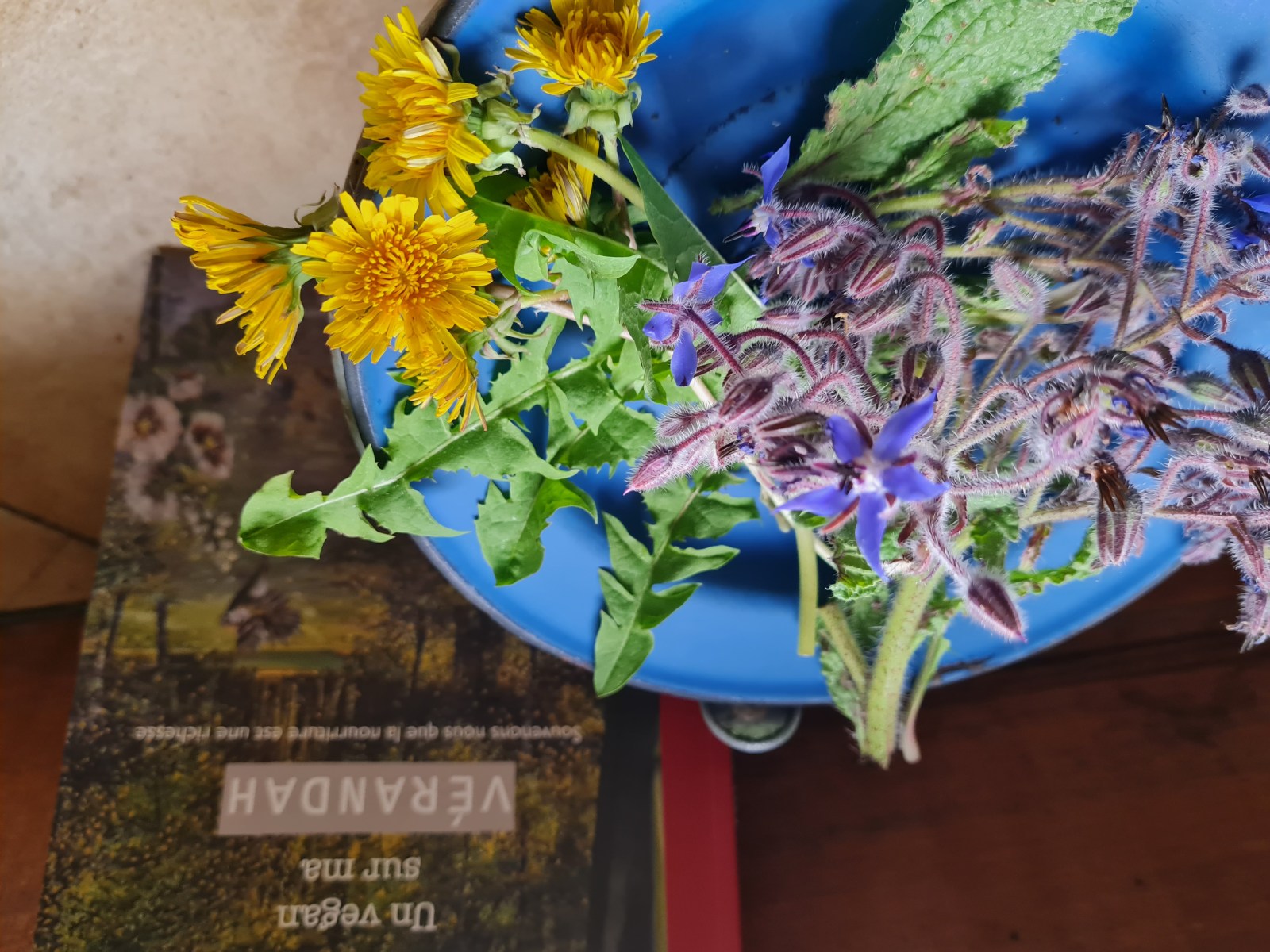
Borage and dandelion flowers, and the French translation of ‘There’s a Vegan on My Verandah’. (Photo: Marita van der Vyver)
If you’re still not convinced of the delights of weed eating, let me remind you that the official logo of Larousse, renowned publishers of reference books including that massive foodie Bible, Le Grand Larousse Gastronomique, is a picture of a woman blowing on the puffball of a dandelion. The original logo was created by the artist Eugène Grasset in the 1800s, to symbolise knowledge being spread in all the wind directions. Although it has been modernised through the decades, the current version still features a stylised woman’s head and a dandelion.
And if this modest weed is good enough for Larousse Gastronomique, it is certainly good enough for my kitchen. DM/TGIFood



 Become an Insider
Become an Insider
Comments - Please login in order to comment.